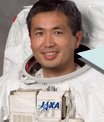JAXA Astronaut Activity Report, July 2007
Last Updated: October 1, 2007
This is JAXA's Japanese astronaut primary activity report for July 2007.
International Space Station (ISS) Expedition Operations Training in Russia
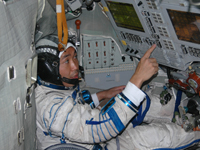
Astronaut Wakata training in the Soyuz spacecraft’s Descent Module simulator(©JAXA/GCTC)
Astronaut Koichi Wakata, who will stay on board the International Space Station (ISS) as a member of the ISS Expedition 18 crew, and astronaut Soichi Noguchi, who is astronaut Wakata’s backup, participated in a training program for long-duration missions aboard the ISS. This training was held at the Gagarin Cosmonaut Training Center (GCTC) located on the Black Sea coast.
At GCTC, the astronauts attended lectures and received training using simulators so as to acquire expertise in operating the power system, the Fire Detection and Suppression (FDS) system, the Motion Control System, and navigation systems. The sessions also included training on the Soyuz spacecraft’s structure, equipment, and Life Support System (LSS).
In addition, the two astronauts participated in water survival training off the Black Sea coast.
In the unlikely event that an anomaly occurs during launch or descent, the Soyuz spacecraft’s Descent Module may be forced to make an emergency landing in the sea. For this purpose, water survival training was conducted so as to acquaint the astronauts with the techniques and procedures used for surviving in the sea until rescue assistance arrives.
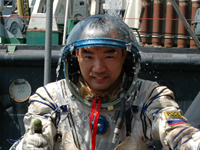
Astronaut Noguchi being hoisted out of the sea after completing his training(©JAXA/GCTC)

Astronaut Wakata practicing escaping from the Soyuz spacecraft’s Descent Module by jumping from the Descent Module’s hatch(©JAXA/GCTC)
During this training, the astronauts were trained on the escape procedures from the Soyuz spacecraft’s Descent Module after landing in the water, as well as water survival techniques. As part of the Descent Module escape training, the astronauts boarded the Descent Module while wearing their Sokol pressurized space suits that are used for launch and reentry. Inside the confining space of the Descent Module, the astronauts changed into clothing for protection against the cold, and donned their “Forel” waterproof survival suits that enable them to float on the sea. The astronauts escaped by jumping from the Descent Module’s hatch into the water while carrying their survival kits with them. In addition, the astronauts drilled on escaping from the Descent Module for when there is insufficient time to change suits inside the Descent Module and escaping while equipped with only emergency flotation bags for survival in the sea. The astronauts were also trained on the need to keep in formation, after escaping into the sea, as a means of keeping together and not becoming separated while waiting to be rescued.
Space Shuttle Post-Insertion Training
Astronaut Takao Doi with his 1J/A (STS-123) mission crew members, participated in the space shuttle’s post-insertion operations training that was conducted at NASA’s Johnson Space Center (JSC).
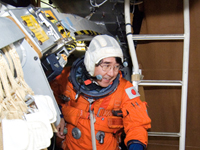
Astronaut Doi participating in the space shuttle post-insertion training
When the shuttle reaches orbit approximately 8 minutes and 30 seconds after launch, the space shuttle changes from a launch vehicle to a spacecraft for working and traveling in space. Upon reaching orbit, the space shuttle crew members will help each other remove their pressurized suits (orange flight suits) and will rearrange the space shuttle’s Flight Deck and Middeck for on-orbit operations and for living and working in an on-orbit space environment.
This training session used the space shuttle’s full-scale mockup. The crew, while taking their owns seats on the Flight Deck and Middeck, simulated a series of tasks by following timelines from launch to when the shuttle reaches orbit.
National Outdoor Leadership School: NOLS
Astronaut Akihiko Hoshide, together with his 1J (STS-124) mission crewmates, as well as NASA’s Flight Directors, participated in the National Outdoor Leadership School (NOLS) in Alaska, USA.
The NOLS training program is conducted under stressful conditions, similar to those experienced in space. The NOLS provided the astronauts with an understanding of self-awareness, leadership, teamwork, followership, and judgment skills. With this training, the astronauts will be able to respond and react to changing situations under extreme conditions.
During the training, the participants took turns being the leader for the day. All of them cooperated with each other while living in the harsh outdoors. The training was conducted along the coastlines of Alaska. The participants traveled by sea kayak. They traveled nearly 80 nautical miles during the 10 days of NOLS. They also received lectures on teamwork and leadership from the instructors, while experiencing the outdoor life together.
NASA/JAXA Joint Simulation (Joint Multi-Segment Training: JMST)
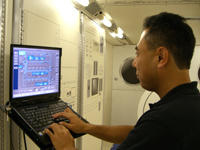
Astronaut Furukawa participating in JMST
JAXA has regularly been conducting Joint Multi-Segment Training (JMST) with NASA for simulating the Kibo Pressurized Module (PM) operations, as part of the on-going preparations for operating Kibo on orbit.
The JMST is an operational simulation training session that NASA conducts by linking to the ISS international partners’ network, control and other remote control facilities through linked communication channels. Both JAXA and NASA Flight Controllers participated in the training so as to develop the necessary understanding and techniques for the joint operations of Kibo.
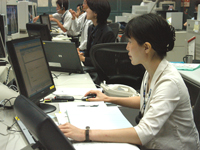
Astronaut Yamazaki participating in JMST
On July 11, astronaut Satoshi Furukawa participated in the JMST from NASA’s JSC by simulating a crew member on orbit. On July 27, astronaut Naoko Yamazaki at the Tsukuba Space Center (TKSC) participated in the JMST by simulating the CAPCOM (Capsule Communicator) who’ll be communicating with the crew on orbit.
The training focused on resolving anomalies and emergencies that may occur while Kibo is on-orbit and after the 1J (STS-124) mission is completed. Through this training, both astronauts Furukawa and Yamazaki gained an understanding of how the flight controllers resolve anomalies and emergencies, and deepened their understanding of Kibo’s operations.




